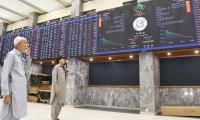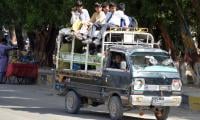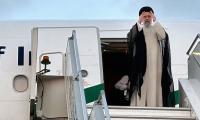Part - II
Allama Iqbal envisaged a commonwealth/confederation of the Muslim Ummah which stretched from the shores of the Nile to the foothills of Pamir. However, he died in 1938, before the Eastern Turkestan Republic was proclaimed in 1944. Nor did he live to see the partition of India and the rise of Mao’s peasant army.
China became a strategic partner of Pakistan. In Pakistan, though, militant Maoists – inspired by the peasants’ revolution in China – were confronted by both the state and the Islamists (the Islamists did not challenge China, however). Islamists like Maulana Maudoodi wrote against communism and were deadly opposed to the advocacy of land reforms and occupation of land by peasants. The Maoist intelligentsia led peasant rebellions to fight both landlords and the state from 1967-1977 whenever the opportunity arose, while pro-Moscow communists tried to support and infiltrate nationalist and ethnic movements.
Interestingly, the Maoist intelligentsia was from the professional middle classes and considered feudalism primordial. The pro-Moscow communists backed the ethnic movements led by landlords and tribal chieftains (in West Pakistan) in their struggle against the Pakistani state and American imperialism. China looked at the Maoist movements in Pakistan and India keeping in mind its strategic interests. Pakistan and China also considered the National Awami Party governments in KP (then NWFP) and Balochistan as pro-Moscow; and NAP’s leadership castigated the Hashtnagar Peasants’ upheaval as a conspiracy hatched by Z A Bhutto’s central government.
Communists of all shades held imperialism responsible for what Andre Gunder Frank termed ‘the development of underdevelopment’ in the third world. With China’s adjustment to neo-liberalism in the 1970s and the deterioration of the peasant movements in 1980, middle-class Maoists intellectuals became postmodernist.
There were communists in Afghanistan inspired by Chinese Maoism. China also joined the US, Pakistan and Saudi Arabia’s camp in supporting the Afghan struggle in opposition to Russian occupation of Afghanistan in the 1980s.
It seems that mainstream middle class Islamist movements in Pakistan did not take a strict stance against China. The reasons were many: first, the Sino-India border war and Sino-Soviet rift in the early 1960s. Pakistan also became a close ally of China. Furthermore, unlike Soviet Russia, China was less ambitious about the nationalist freedom movements and ethnic politics; and Islamists were bitterly opposed to the nationalists and ethnic movements. Another factor could be that China kept the Maoists at an arm’s length and did not extend support to militant peasant movements in their fight against landlords and Pakistani state. China also backed the Afghan jihad in the 1980s.
Then there was the technical support provided by the Chinese in the development of Pakistan’s nuclear capabilities and missiles’ programmes – which was very important for the Islamists. For Islamists, Pakistan become ‘the fort of Islam’ – the only Muslim nation with nukes. It was also noteworthy that China did not export Maoism nor did it follow an imperialist design. China also, in one way or the other, fought or supported the war against India and Russia. Since the 1990s the progress of Chinese capitalism also inspired the Islamists in Pakistan. And reformist Islamic parties and organisations also followed the same model of development promoted by international financial institutions.
More factors would also include the fact that China, Saudi Arabia and the Gulf countries (GCC) pursue high growth rate and rapid development without any labour and human rights. Islamists also see the growing economic and military power of China as a countervailing force that might balance American imperialism in the near future.
Some Uyghur Islamists were already part of the global jihadi organisations in the Af-Pak region. Johan Blank of the Rand Corporation gives credit to Pakistan’s security agencies for influencing Islamic movements to keep China out of their narrative. His analysis is especially inappropriate for the 2000s. He tends to obscure the underlying differences between the Pakistani Taliban and reformist Islamic organisations. The Jamaat-e-Islami and the Jamiat Ulema-e-Islam (JUI-F) have less influence over the Pakistani Taliban. The JI championed the Afghan jihad in the 1980s, while the JUI was influential from 1995 to 2005.
However, the nexus between the Taliban and former jihadi and reformist political Islamic organisations is tenuous, and they lost influence once the Pakistani Taliban took on Pakistan’s security forces in 2003. The weakness in Blank’s analysis seems to lie in the very fact that the social base of the Taliban is very different from that of the mujahideen of the 1980s and Islamic reformist political parties.
The Taliban are recent migrants to cities. Therefore, their worldview about capitalist development and their attitude towards the Pakistani state and China are very different from those of the mujahideen and reformist Islamists. In fact, the Pakistani Taliban closely worked with Kashghari and Uyghur Muslims in the Af-Pak region. In the background of the Afghan war, and later Taliban control over Afghanistan, Al-Qaeda played an important role in the formation of an Islamic alliance of militants from various parts of the world. But there is little information about Uyghur militants and their numerical strength in the Af-Pak region.
To be continued
The writer is an independent researcher. Email: sartaj2000@yahoo.com
A health worker administers polio vaccine drops to a child during a door-to-door polio vaccination campaign in Lahore,...
Armed militants of the banned Tehreek-e-Taliban Pakistan pose for a photograph in Orakzai Agency. —...
An aeroplane of the national flag carrier of Pakistan is seen in this file photo. — AFPWhile Pakistan considers...
Representational image of a graph depicting various variables. — APP/FileInitiated by the centre and fiercely...
In this picture taken on April 16, 2023, people throng a market area during shopping in Lahore. — AFPOne of the...
Honour crimes also target men. In Sikandar Ali Lashari vs The State, SHC upheld conviction passed by ATC for honour...







